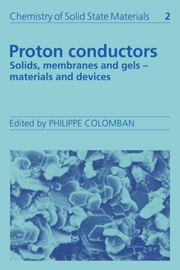Book contents
- Frontmatter
- Contents
- List of contributors
- Preface
- Symbols
- I HYDROGEN BOND AND PROTONIC SPECIES
- II MATERIALS: PREPARATION, STRUCTURES AND PROPERTIES
- 7 Structure and characterization of hydrogen insertion compounds of metal oxides
- 8 High temperature proton conductors based on perovskite-type oxides
- 9 Highly ionic hydroxides: unexpected proton conductivity in Mg(OH)2 and homologues
- 10 Ice
- 11 Anhydrous materials: oxonium perchlorate, acid phosphates, arsenates, sulphates and selenates
- 12 Hydrogen behaviour in graphite–nitric acid intercalation compounds
- 13 Proton-containing β- and β″-alumina structure type compounds
- 14 Proton conduction in zeolites
- 15 Proton containing NASICON phases
- 16 Phosphates and phosphonates of tetravalent metals as protonic conductors
- 17 Hydrogen uranyl phosphate, H3OUO4PO4. 3H2O (HUP), and related materials
- 18 From crystalline to amorphous (particle) hydrates: inorganic polymers, glasses, clays, gels and porous media
- 19 Perfluorinated membranes
- 20 Mixed inorganic-organic systems: the acid/polymer blends
- III PROTON DYNAMICS AND CHARGE TRANSPORT
- IV PROTON DIFFUSION MECHANISMS
- V DEVICES
- Index
12 - Hydrogen behaviour in graphite–nitric acid intercalation compounds
Published online by Cambridge University Press: 04 May 2010
- Frontmatter
- Contents
- List of contributors
- Preface
- Symbols
- I HYDROGEN BOND AND PROTONIC SPECIES
- II MATERIALS: PREPARATION, STRUCTURES AND PROPERTIES
- 7 Structure and characterization of hydrogen insertion compounds of metal oxides
- 8 High temperature proton conductors based on perovskite-type oxides
- 9 Highly ionic hydroxides: unexpected proton conductivity in Mg(OH)2 and homologues
- 10 Ice
- 11 Anhydrous materials: oxonium perchlorate, acid phosphates, arsenates, sulphates and selenates
- 12 Hydrogen behaviour in graphite–nitric acid intercalation compounds
- 13 Proton-containing β- and β″-alumina structure type compounds
- 14 Proton conduction in zeolites
- 15 Proton containing NASICON phases
- 16 Phosphates and phosphonates of tetravalent metals as protonic conductors
- 17 Hydrogen uranyl phosphate, H3OUO4PO4. 3H2O (HUP), and related materials
- 18 From crystalline to amorphous (particle) hydrates: inorganic polymers, glasses, clays, gels and porous media
- 19 Perfluorinated membranes
- 20 Mixed inorganic-organic systems: the acid/polymer blends
- III PROTON DYNAMICS AND CHARGE TRANSPORT
- IV PROTON DIFFUSION MECHANISMS
- V DEVICES
- Index
Summary
Graphite intercalation compounds
Graphite crystallizes in a structure which consists of stacked carbon atom layers in which each carbon atom is bonded to three neighbours in a hexagonal lattice. Foreign atoms or molecules can slip between graphite layers without completely disrupting the structure of the host material. During the past ten years, these GICs have been the subject of numerous studies as they present interesting application possibilities: electrical conductors, catalysts, high energy density batteries, lubricants and membranes. A good survey is given in the review Intercalated Materials where the synthesis, structure and physical properties of GICs with metals, halogens, halogenides, oxides and acids are described.
In the last century, Brodie and Schafhautl reported the intercalation, between graphite layers, of a mixture of sulphuric and nitric acids. More recently, Rüdorff determined the X-ray diffractograms of (GNCs) Graphite-Nitric acid Compounds. GNCs can be prepared by using dilute nitric acid or pure HNO3 as well as dinitrogen pentoxide mixed with, or without, nitric acid. The best way to avoid swelling and distortion of pyrolytic graphite samples and to prepare high quality GNCs, is to intercalate, step by step, small amounts of pure nitric acid vapour.
The GNCs behave as good p-type conductors, which is the reason why Ubbelhode described them as ‘Synthetic Metals,’ in agreement with a structural model in which the carbon hexagonal network acts as a macrocation with intercalation of nitrate ions and molecules of nitric acid.
- Type
- Chapter
- Information
- Proton ConductorsSolids, Membranes and Gels - Materials and Devices, pp. 183 - 189Publisher: Cambridge University PressPrint publication year: 1992
- 1
- Cited by



